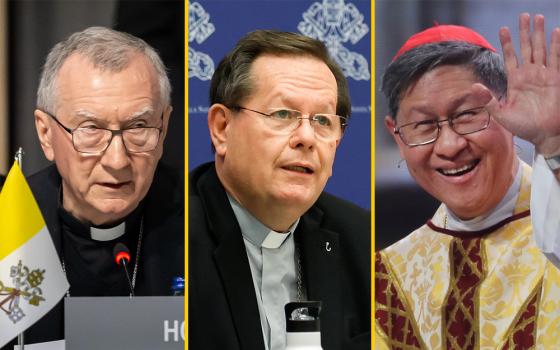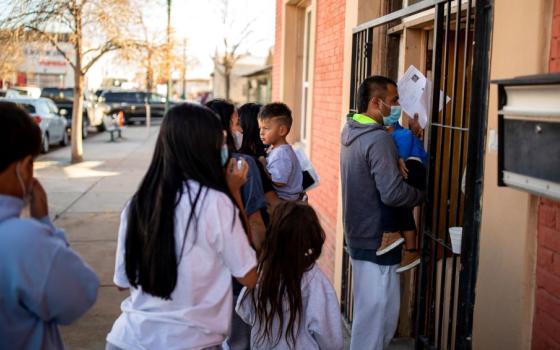In telling the story of the seven brothers and their mother, the ancient author has infused the narrative with the doctrine of the resurrection. At the point of death, each brother made a statement that declared his faith in God and in the resurrection, in which he placed all his hope. Their mother did the same. Each declaration of faith built upon the ones that preceded it. All the declarations together formed an eloquent doctrinal summary of resurrection, retribution and reward — encouragement to all who are made to suffer unjustly for their beliefs. However, and unfortunately so, this presentation has been abridged, shortened for whatever reason, and listeners gathered for liturgy are not told the rest of the story. The lectionary includes only the declarations and martyrdoms of four of the brothers. This narrative, like so many other readings in the lectionary, has been edited; verses have been omitted. Therefore, it devolves upon the homilist to make known the entire passage. Similarly, when a shorter form of a gospel is offered, wouldn’t it be better to opt for the longer form? Or, are we in such a hurry that we cannot listen to a few more sentences and maintain the integrity of the good news?
That good news for Nov. 6 continues with Paul’s wise counsel to the Thessalonians. Paul’s confidence in God and in the Gospel he preached were so contagious that he had managed to establish in that Greek city a viable and enthusiastic community. So excited were they at the prospect of Jesus’ second appearance that Paul had to teach them how to wait and work and pray so as to be ready to welcome Jesus, however “soon” or “late” he might come. We who continue to await the Lord also continue to benefit from Paul’s advice.
Like the first reading, the Gospel for Nov. 6 focuses on resurrection. Although they held no faith in resurrection, the Sadducees confronted Jesus with an argument based on the legal prescription that a man, whose brother has died, should raise up children by taking his widow as his wife (Deuteronomy 25:5-6; Genesis 38:8). Their supposed case of a woman who had been married to seven brothers sought to render belief in the resurrection as absurd. As Brendan Byrne (The Hospitality of God, The Liturgical Press, Collegeville, MN: 2000) has noted, the Sadducees’ argument “rests upon a crass assumption that life after death would simply be a repetition or extension of life in the present time, with the same conditions applying.” This flaw in their argument enabled Jesus to offer much needed clarification. Those who are risen to life in God live as a totally new creation. There is no need for marriage; all are children of the God of Moses, Abraham, Isaac and Jacob. God is a God not of the dead but of the living. And there you have it — the rest of the story.
2 MACCABEES 7:1-2, 9-14
Of the four books called Maccabees, only the first two have been accepted into the scriptural canon by the Catholic Church. Despite the fact that this literature bears valuable testimony to Jewish courage and faith, later disputes concerning Hasmonean policies and disappointment over certain instances of corruption contributed to the omission of these books from the Palestinian Canon.
Named for Judas Maccabeus, one of the sons of the priest Mattathias, who instigated the Jewish revolt of 167 B.C., the word Maccabee is popularly believed to mean “the hammer,” an apt term for the power of the revolutionaries as they resisted their Seleucid (Syria) oppressors. However, most scholars agree that the name is probably derived from the Hebrew maggabyahu, which means “designated by God.”
Written before 1 Maccabees, 2 Maccabees was the work of a Hellenistic Jew from the Diaspora, an epitomist who based his efforts on the work of an earlier author, Jason of Cyrene. While Jason’s five-volume work has never been recovered, the author of 2 Maccabees, writing ca 100 B.C., has preserved most of Jason’s records regarding the events that precipitated the Jewish rebellion. His purpose was to edify and encourage his Jewish contemporaries in their resistance to those Greek ways that posed a threat to Jewish faith and traditions.
Following the policies of Alexander, his successors continued his efforts to inculcate Greek philosophy and culture throughout the empire. Some, more liberal Jews welcomed Hellenization as a necessary aspect of higher civilization. Others refused to be assimilated and held on to their Jewish heritage to the point of offering even their lives, as did the seven brothers and their mother in today’s first reading. Some even went so far as to withdraw from society in order to preserve and practice their faith. These Hasidim or “pious ones” were the forerunners of the later Pharisaic party. Fierce defenders of the law, they were willing to fight and die in order to preserve their heritage intact.
Today’s first reading, although incomplete, details some of the atrocities that were inflicted upon Jews during the Seleucid persecutions. In telling the story of the seven brothers and their mother, the ancient author wished to present his contemporaries with heroes who would inspire them to be similarly tenacious in their faith and courageous in the defense of their Jewish ways.
While the doctrine of the resurrection began to develop within Judaism at this time (ca 200 B.C.), it was not universally accepted. As reflected in today’s gospel, this doctrine remained a controversial issue and was the source of many theological debates among Jesus’ contemporaries.
2 THESSALONIANS 2:16-3:5
Among the earliest of all the New Testament writings, the two letters to the believers in Thessalonica (present day Salonika), offer modern readers a valuable glimpse into the nascent church as it struggled to develop its own identity in the absence of the earthly Jesus. Although the letters were written within a mere two decades of Jesus’ resurrection, they reflect considerable development of doctrine. Scholars have identified the following doctrinal truths in 1 and 2 Thessalonians: (1) Jesus is proclaimed as Lord and Son of God who has been raised from the dead; (2) God gives the Holy Spirit to those who believe in the good news of Jesus; (3) Believers will experience the Day of the Lord when Christ returns as judge and redeemer of all of humankind; (4) The lives of those who believe in Jesus should be characterized by faith, hope and love; (5) Persecution and suffering are integral to the life of the committed believer.
Because Jesus’ return was a burning issue for those earliest believers, this subject was given preeminent importance in these first letters. In the first letter, Paul instructed the Thessalonians to recall the teachings of Jesus as he had handed them on to them, namely that the Lord would surely come and share his risen glory with the faithful, but no one knew when he would come. When the Thessalonians expressed their heartfelt concern for those who died before Jesus’ appearance, Paul assured them that the faithful dead would also rise and be taken up into glory along with the living.
In the second letter, the shift of thought regarding the parousia led many to suggest an author other than Paul. The apostasy therein described and the man of lawlessness, or Antichrist, seem to be the problems of a later time. Nevertheless, both letters are consistent in calling all believers to prepare for the Lord’s coming in prayer, hope and faithful service.
Comprised of three short prayers, this text represents the author’s desire that the community would remain consistent in their efforts and be consoled in the fact that theirs was truly the work of the gospel. The author also requested prayers for himself and his ministry. Well aware of the struggles and challenges he would encounter, the great apostle (or one who wrote in his name) expressed the conviction already held by the first century church: that intercessory prayer is one of the greatest resources of the church. That resource carries the work of the Lord to succeed and progress. Today, no less than in the first Christian century, the prayer of believers united in Jesus’ name is a force for good in the world.
LUKE 20:27-38
In Jesus’ day, the political situation greatly affected the attitudes toward religion of the various elements of society. Two of the major political forces were Hellenization and the Roman Empire. Whereas Hellenism could be described as the cultural infiltration of Greek ways into every aspect of Jewish life, the Roman Empire constituted the power that dominated all lives in its jurisdiction and controlled their freedoms. In reaction to these political forces, various parties emerged, such as the Pharisees, Sadducees, Essenes, Herodians, Zealots, etc., each with their own method of dealing with the politics of the day.
While the Essenes’ choice was to withdraw from society completely, the Zealots favored active resistance that led to the Jewish revolt in A.D. 66. A short-lived group, the Herodians tried to promote Herod as the messiah who would save his people from all other powers. But the two major parties were the Pharisees and the Sadducees. Their differing theologies formed the basis of the dispute featured in today’s gospel.
While the Sadducees accepted only the Pentateuch as normative, the Pharisees were open to and accepting of the development of doctrines found in later Jewish Scriptures, e.g., angels, resurrection, final judgment, afterlife, etc. The Pharisees had also developed an oral law called “the traditions of the elders” in which they interpreted and expanded the Torah to apply to every imaginable circumstance. Theologically, Jesus favored the Pharisaic point of view; however he considered the law as a bond of love rather than as a burden of minutiae. For this reason, he often clashed with the Pharisaic insistence upon parsing the law to the point of misconstruing its purpose.
On this occasion, the Sadducees, who did not believe in the resurrection, presented Jesus with questions intended to provoke an argument. But Jesus, not to be drawn in by them, offered them a counterchallenge, citing the only authority the Sadducees accepted — Moses. Jesus explained that when God appeared to Moses in the burning bush (Exodus 3), God was identified as the God of the patriarchs: Abraham, Isaac and Jacob. Though they had been dead for centuries, if God is truly the God of the living, they must somehow be alive, argued Jesus.
Jesus’ statement implied that when God has a relationship with someone, as God did with the patriarchs, that relationship is never dissolved, not even by death. Asserting his conviction about the resurrection, Jesus challenged the Sadducees, who quoted the Mosaic Law on levirate marriage (Deuteronomy 25:5; Genesis 38:8), to accept the same Mosaic authority on immortality.
Jesus also explained that everlasting life is not merely a continuation of life on earth but an entirely new mode of existence where marriage to perpetuate the human race is no longer necessary. Those who rise to be with God forever are like angels, children of God, brothers and sisters of Jesus who lived and died and rose again for us all. And … this is the rest of the story.
Planning: 32nd Sunday in Ordinary Time (C)
By: Lawrence Mick
As we enter into the month of November, a month when we traditionally reflect on death and those who have died, our first reading and gospel focus our attention on death and resurrection. The reading from 2 Maccabees gives us part of the tale of seven brothers and their mother who accepted death rather than renounce their faith.
This story is one of the few passages in the Hebrew Scriptures that reflect a strong belief in life after death. As the fourth brother insists, “It is my choice to die at the hands of men with the hope God gives of being raised up by him …”
The Gospel passage makes it clear that Jesus believed in life after death. The Sadducees did not, which is why they challenged him in this episode. But he insists: “That the dead will rise even Moses made known in the passage about the bush, when he called out ‘Lord,’ the God of Abraham, the God of Isaac, and the God of Jacob; and he is not God of the dead, but of the living, for to him all are alive.”
Surveys show that many people today no longer believe in life after death, and that group includes some Catholics. This is a good month to reaffirm our belief in the resurrection. That may be done as powerfully by our actions as by our words. If we honor those who have died in the past year, for example, we nourish the hope of those left behind that their loved ones are still alive and waiting for them.
Preaching on this belief and prayers that support it are also appropriate, of course. Planners might make a point to include at least one petition each week this month for those who have difficulty trusting in the promise of resurrection.
Planners should also discuss the best ways to remember those who have died. In a small parish with a limited number of funerals each year, the names of those who have died might be included in the petitions, dividing up the list over the four Sundays (or maybe the first three Sundays, since Advent begins on Nov. 27). Parishes with larger lists of deceased might post the names on a poster at each entrance that encourages prayer for them and their families. Some parishes have a “Book of the Dead” in which the names are inscribed each year. Planners should also discern if it would be helpful to have a special evening Mass or prayer service some evening during November that would gather families who have lost someone this year to gather for prayer and mutual support.
Planning: 32nd Sunday in Ordinary Time (C)
By: Joan DeMerchant
Introduction
“What comes next?” is an old question about life after death. Today’s readings encourage persistence in the face of the unknown. We Christians are heirs of faith in the resurrection (not a Jewish belief), but that does not guarantee courage in living our faith in the here and now. Keeping our eye on life beyond death is critical, but how we live our faith each day is equally important.
Penitential Act
- Lord Jesus, you faced the denial of life after death: Lord, have mercy.
- Christ Jesus, you taught and showed the meaning of resurrection: Christ, have mercy.
- Lord Jesus, you call us to live life fully in the light of resurrection: Lord, have mercy.
Prayer of the Faithful
Presider My friends, we are called to live in the light of the resurrection, and so we pray for all who inhabit this fragile planet with us.
Minister For the church: that it may demonstrate the meaning of the resurrection…we pray,
- For encouragement for those yearning for peace in the face of war, violence and conflict…we pray,
- For encouragement for those struggling to make ends meet for themselves and their families…we pray,
- For reassurance for those who do not have all the answers in life…we pray,
- For those who struggle to believe in resurrection, especially those who have lost a loved one…we pray,
- For encouragement for those who fear the outcomes of the coming election and for those charged with leading us into the future…we pray,
- For all we are called to minister to in this community and beyond…we pray,
- For those sick, the dying and those who have died…(names)…; and for those who minister to the dying and grieving…we pray,
Presider God of everlasting life: keep us hopeful in what lies beyond, while we struggle to live life fully each and every day. Help us to be people of faith and hope, who encourage those who have lost hope. We ask this in the name of your son, Jesus, who showed us the meaning and purpose of life. Amen.
Advertisement




